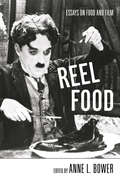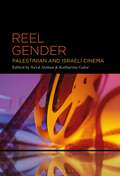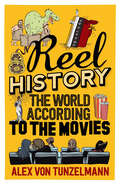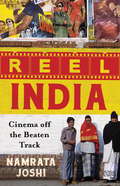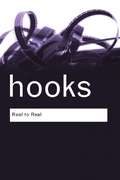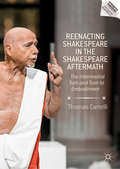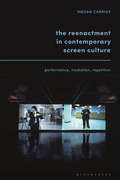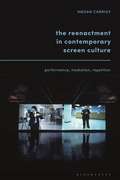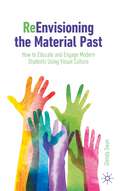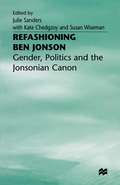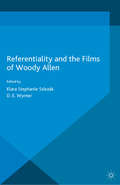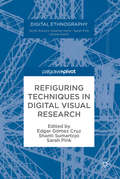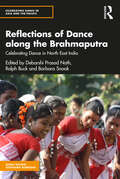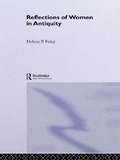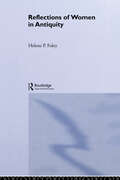- Table View
- List View
Reel Food: Essays on Food and Film
by Anne L. BowerFirst published in 2005. Routledge is an imprint of Taylor & Francis, an informa company.
Reel Gender: Palestinian and Israeli Cinema
by Sa’ed Atshan and Katharina GalorReel Gender is a groundbreaking collection that addresses the collective realities and the filmic representations of Palestinian and Israeli societies. The eight essays, by leading scholars, demonstrate how Palestinian and Israeli film production-despite obvious overlaps and similarities and while keeping in mind the inherent asymmetry of power dynamics-are at the forefront of engaging gender and sexuality. The scholars of this volume construct and deconstruct still and moving images, characters, and stories that create an entanglement of Palestinian and Israeli cinema. Together they portray the region's diverse but unexpectedly intermingled ethnic, religious, and national communities, framed or countered by various societal norms, laws, and expectations, while also defined by colonial realities. The essays draw methodologically from the fields of media and cultural studies, critical and postcolonial theory, feminism, post-feminism, and queer theory.
Reel Gender: Palestinian and Israeli Cinema
Reel Gender is a groundbreaking collection that addresses the collective realities and the filmic representations of Palestinian and Israeli societies. The eight essays, by leading scholars, demonstrate how Palestinian and Israeli film production-despite obvious overlaps and similarities and while keeping in mind the inherent asymmetry of power dynamics-are at the forefront of engaging gender and sexuality. The scholars of this volume construct and deconstruct still and moving images, characters, and stories that create an entanglement of Palestinian and Israeli cinema. Together they portray the region's diverse but unexpectedly intermingled ethnic, religious, and national communities, framed or countered by various societal norms, laws, and expectations, while also defined by colonial realities. The essays draw methodologically from the fields of media and cultural studies, critical and postcolonial theory, feminism, post-feminism, and queer theory.
Reel History: The World According to the Movies
by Alex von TunzelmannFrom ancient Egypt to the Tudors to the Nazis, the film industry has often defined how we think of the past. But how much of what you see on the screen is true? And does it really matter if filmmakers just make it all up? Picking her way through Hollywood's version of events, acclaimed historian Alex von Tunzelmann sorts the fact from the fiction. Along the way, we meet all our favourite historical characters, on screen and in real life: from Cleopatra to Elizabeth I, from Spartacus to Abraham Lincoln, and from Attila the Hun to Nelson Mandela.Based on the long-running column in the Guardian, Reel History takes a comic look at the history of the world as told through the movies - the good, the bad, and the very, very ugly.
Reel India: Cinema off the Beaten Track
by Namrata Joshi‘Picture abhi baaki hai…’ If there’s one experience that unites India, it is cinema. In Reel India, award-winning film critic Namrata Joshi journeys through the interiors of the country intimately chronicling little-known accounts about the nation’s incessant obsession with the movies. In Lucknow, she encounters a Shah Rukh Khan fan who has embraced an alternate reality in which he lives and breathes the star. In Wai, she finds an entire economy fuelled by the film industry as the town transforms into a film set. An activist filmmaker in Odisha demonstrates how he teaches local tribal people the basics of his craft, empowering them to train the spotlight on issues threatening their habitat and livelihood. From the fever pitch of the ‘first day first show’ in makeshift halls to the rivalries of regional cinema, this is India’s immersion in the movies like it’s never been seen before. Filled with real-life stories that are as fascinating as the revelations and insights they offer, Reel India raises the curtain on the starry-eyed dreams and big-screen passions that live on after the final ‘cut’ is announced.
Reel to Real: Race, Sex and Class at the Movies
by Bell HooksMovies matter – that is the message of Reel to Real, bell hooks’ classic collection of essays on film. They matter on a personal level, providing us with unforgettable moments, even life-changing experiences and they can confront us, too, with the most profound social issues of race, sex and class. Here bell hooks – one of America’s most celebrated and thrilling cultural critics – talks back to films that have moved and provoked her, from Quentin Tarantino’s Pulp Fiction to the work of Spike Lee. Including also her conversations with master filmmakers such as Charles Burnett and Julie Dash, Reel to Real is a must read for anyone who believes that movies are worth arguing about.
Reel to Real: Race, Sex and Class at the Movies
by Bell HooksMovies matter – that is the message of Reel to Real, bell hooks’ classic collection of essays on film. They matter on a personal level, providing us with unforgettable moments, even life-changing experiences and they can confront us, too, with the most profound social issues of race, sex and class. Here bell hooks – one of America’s most celebrated and thrilling cultural critics – talks back to films that have moved and provoked her, from Quentin Tarantino’s Pulp Fiction to the work of Spike Lee. Including also her conversations with master filmmakers such as Charles Burnett and Julie Dash, Reel to Real is a must read for anyone who believes that movies are worth arguing about.
Reenacting Shakespeare in the Shakespeare Aftermath: The Intermedial Turn and Turn to Embodiment (Reproducing Shakespeare)
by Thomas CartelliIn the Shakespeare aftermath—where all things Shakespearean are available for reassembly and reenactment—experimental transactions with Shakespeare become consequential events in their own right, informed by technologies of performance and display that defy conventional staging and filmic practices. Reenactment signifies here both an undoing and a redoing, above all a doing differently of what otherwise continues to be enacted as the same. Rooted in the modernist avant-garde, this revisionary approach to models of the past is advanced by theater artists and filmmakers whose number includes Romeo Castellucci, Annie Dorsen, Peter Greenaway, Thomas Ostermeier, Ivo van Hove, and New York’s Wooster Group, among others. Although the intermedial turn taken by such artists heralds a virtual future, this book demonstrates that embodiment—in more diverse forms than ever before—continues to exert expressive force in Shakespearean reproduction’s turning world.
The Reenactment in Contemporary Screen Culture: Performance, Mediation, Repetition
by Megan CarrigyDuring the first decades of the 21st century, a critical re-assessment of the reenactment as a form of historical representation has taken place in the disciplines of history, art history and performance studies. Engagement with the reenactment in film and media studies has come almost entirely from the field of documentary studies and has focused almost exclusively on non-fiction, even though reenactments are being employed across fiction and non-fiction film and television genres. Working with an eclectic collection of case studies from Milk, Monster, Boys Don't Cry, and The Battle of Orgreave to CSI and the video of police assaulting Rodney King, this book examines the relationship between the status of theatricality in the reenactment and the ways in which its relationships to reference are performed. Carrigy shows that while the practice of reenactment predates technically reproducible media, and continues to exist in both live and mediated forms, it has been thoroughly transformed through its incorporation within forms of technical media.
The Reenactment in Contemporary Screen Culture: Performance, Mediation, Repetition
by Megan CarrigyDuring the first decades of the 21st century, a critical re-assessment of the reenactment as a form of historical representation has taken place in the disciplines of history, art history and performance studies. Engagement with the reenactment in film and media studies has come almost entirely from the field of documentary studies and has focused almost exclusively on non-fiction, even though reenactments are being employed across fiction and non-fiction film and television genres. Working with an eclectic collection of case studies from Milk, Monster, Boys Don't Cry, and The Battle of Orgreave to CSI and the video of police assaulting Rodney King, this book examines the relationship between the status of theatricality in the reenactment and the ways in which its relationships to reference are performed. Carrigy shows that while the practice of reenactment predates technically reproducible media, and continues to exist in both live and mediated forms, it has been thoroughly transformed through its incorporation within forms of technical media.
ReEnvisioning the Material Past: How to Educate and Engage Modern Students Using Visual Culture
by Glenda SwanThis book is designed to help instructors effectively incorporate images and other aspects of material culture into their pedagogy in an engaging and relatable manner. The author draws on her personal experiences as an art historian of ancient art who instructs a wide variety of undergraduates. In addition to helping students to look and think critically, the book explores how the material culture of the past can be a potent tool in motivating student involvement with course content and sharpening skills vital for navigating contemporary culture.
Refashioning Ben Jonson: Gender, Politics, and the Jonsonian Canon
by Julie Sanders Kate Chedgzoy Susan WisemanThis collection of multi-authored essays not only refashions and revises critical understandings of the early modern dramatist Ben Jonson and his canon of work, but is also self-reflexive about the process. It includes original essays by both established and emergent Jonson scholars, and employs materialist, feminist and queer theory in the production of its readings of Jonsonian playtexts and masques, familiar and otherwise. It is intended to encourage new approaches by students to this central figure from the Renaissance.
Referentiality and the Films of Woody Allen
by D. E. WynterReferentiality and the Films of Woody Allen is a scholarly collection that provides expansive exploration of the auteur's use of intertexuality, referentiality, and fusion of media forms. Its scope is framed by Allen's intermedial phase beginning in 1983 with Zelig and his most recent film.
Refiguring Prose Style: Possibilities For Writing Pedagogy
by T.R. JohnsonFor about two decades, say Johnson and Pace, the discussion of how to address prose style in teaching college writing has been stuck, with style standing in as a proxy for other stakes in the theory wars. The traditional argument is evidently still quite persuasive to some—that teaching style is mostly a matter of teaching generic conventions through repetition and practice. Such a position usually presumes the traditional view of composition as essentially a service course, one without content of its own. On the other side, the shortcomings of this argument have been much discussed—that it neglects invention, revision, context, meaning, even truth; that it is not congruent with research; that it ignores 100 years of scholarship establishing composition's intellectual territory beyond "service." The discussion is stuck there, and all sides have been giving it a rest in recent scholarship. Yet style remains of vital practical interest to the field, because everyone has to teach it one way or another. A consequence of the impasse is that a theory of style itself has not been well articulated. Johnson and Pace suggest that moving the field toward a better consensus will require establishing style as a clearer subject of inquiry. Accordingly, this collection takes up a comprehensive study of the subject. Part I explores the recent history of composition studies, the ways it has figured and all but effaced the whole question of prose style. Part II takes to heart Elbow's suggestion that composition and literature, particularly as conceptualized in the context of creative writing courses, have something to learn from each other. Part III sketches practical classroom procedures for heightening students' abilities to engage style, and part IV explores new theoretical frameworks for defining this vital and much neglected territory. The hope of the essays here—focusing as they do on historical, aesthetic, practical, and theoretical issues—is to awaken composition studies to the possibilities of style, and, in turn, to rejuvenate a great many classrooms.
Refiguring Techniques in Digital Visual Research
by Edgar Gómez Cruz Shanti Sumartojo Sarah PinkThis book interrogates how new digital-visual techniques and technologies are being used in emergent configurations of research and intervention. It discusses technological change and technological possibility; theoretical shifts toward processual paradigms; and a respectful ethics of responsibility. The contributors explore how new and evolving digital-visual technologies and techniques have been utilized in the development of research, and reflect on how such theory and practice might advance what is “knowable” in a world of smartphones, drones, and 360-degree cameras.
Refiguring Techniques in Digital Visual Research
by Sarah Pink Edgar Gómez Cruz Shanti SumartojoThis book interrogates how new digital-visual techniques and technologies are being used in emergent configurations of research and intervention. It discusses technological change and technological possibility; theoretical shifts toward processual paradigms; and a respectful ethics of responsibility. The contributors explore how new and evolving digital-visual technologies and techniques have been utilized in the development of research, and reflect on how such theory and practice might advance what is “knowable” in a world of smartphones, drones, and 360-degree cameras.
Refiguring Techniques in Digital Visual Research
by Sarah Pink Edgar Gómez Cruz Shanti SumartojoThis book interrogates how new digital-visual techniques and technologies are being used in emergent configurations of research and intervention. It discusses technological change and technological possibility; theoretical shifts toward processual paradigms; and a respectful ethics of responsibility. The contributors explore how new and evolving digital-visual technologies and techniques have been utilized in the development of research, and reflect on how such theory and practice might advance what is “knowable” in a world of smartphones, drones, and 360-degree cameras.
Refiguring the Real: Picture and Modernity in Word and Image, 1400-1700
by Christopher BraiderIn a major analysis of pictorial forms from the late Middle Ages to the Enlightenment, Christopher Braider argues that the painted image provides a metaphor and model for all other modes of expression in Western culture—particularly literature, philosophy, religion, and science. Because critics have conventionally explained visual images in terms of verbal texts (Scripture, heroic poetry, and myth), they have undervalued the impact of the pictorial naturalism practiced by painters from the fifteenth century onward and the fundamentally new conception of reality it conveys. By reinterpreting modern Western experience in light of northern "descriptive art," the author enriches our understanding of how both painted and written cultural texts shape our perceptions of the world at large. Throughout Braider draws on works by such painters as van der Weyden, Bruegel the Elder, Steen, Vermeer, Rembrandt, and Poussin, and addresses such topics as the Incarnation of the Word in Christ, the elegiac foundations of Enlightenment aesthetics, and the rivalry between northern and southern art. His goal is not only to reexamine important aesthetic issues but also to offer a new perspective on the general intellectual and cultural history of the modern West.Originally published in 1993.The Princeton Legacy Library uses the latest print-on-demand technology to again make available previously out-of-print books from the distinguished backlist of Princeton University Press. These editions preserve the original texts of these important books while presenting them in durable paperback and hardcover editions. The goal of the Princeton Legacy Library is to vastly increase access to the rich scholarly heritage found in the thousands of books published by Princeton University Press since its founding in 1905.
Reflecting on Practice for STEM Educators: A Guide for Museums, Out-of-school, and Other Informal Settings
by Lynn Uyen Tran Catherine HalversenReflecting on Practice for STEM Educators is a guidebook to lead a professional learning program for educators working in STEM learning environments. Making research on the science of human learning accessible to educational professionals around the world, this book shows educators how to relate this research to their own practice. Educators’ collective work broadens the scope of an organization’s reach, and through this effort, the organization grows its social capital in its local community and beyond. This book offers opportunities to engage in processes that lead toward organizational learning by attending to the professional growth of the educators. Tran and Halversen show how learning together can shape the language and meanings by which educators do and talk about their work to support visitors’ experiences. The book provides guidance on how teams of educators can build community as they engage in reflective practice. Reflecting on Practice for STEM Educators will be essential reading for leaders of any organization that aims to educate and engage the public in science, technology, engineering, and mathematics. It will be particularly useful to educators who work in museums, zoos, aquariums, botanical gardens, youth organizations, after-school programs, and nature, science, and conservation centres.
Reflection In The Writing Classroom
by Kathleen YanceyYancey explores reflection as a promising body of practice and inquiry in the writing classroom. Yancey develops a line of research based on concepts of philosopher Donald Schon and others involving the role of deliberative reflection in classroom contexts. Developing the concepts of reflection-in-action, constructive reflection, and reflection-in-presentation, she offers a structure for discussing how reflection operates as students compose individual pieces of writing, as they progress through successive writings, and as they deliberately review a compiled body of their work-a portfolio, for example. Throughout the book, she explores how reflection can enhance student learning along with teacher response to and evaluation of student writing. Reflection in the Writing Classroom will be a valuable addition to the personal library of faculty currently teaching in or administering a writing program; it is also a natural for graduate students who teach writing courses, for the TA training program, or for the English Education program.
Reflections of Dance along the Brahmaputra: Celebrating Dance in North East India (Celebrating Dance in Asia and the Pacific)
by Debarshi Prasad Nath, Ralph Buck, and Barbara SnookThis volume brings a critical lens to dance and culture within North East India. Through case studies, first-hand accounts, and interviews, it explores unique folk dances of Indigenous communities of North East India that reflect diverse journeys, lifestyles, and connections within their ethnic groups, marking almost every ritual and festival. Dance for people of North East India, as elsewhere, is also a way of declaring, establishing, celebrating, and asserting humans' relationship with nature. The book draws attention to the origins and special circumstances of dances from North East India. It discusses a range of important folk-dance forms alongside classical dance forms in North East India, with a focus on Sattriya dance. The chapters examine how these dance forms play an important role in the region’s socio-cultural, economic, and political life, intertwining religion and the arts through music, dance, and drama. Further, they also explore how folk dance cultures in North East India have never been relegated to the background, never considered secondary, aesthetically, or otherwise, but have become expressions of political and cultural identity. An evocative work, this volume will be of interest to students and researchers of pedagogy, choreography, community dance practice, theatre and performance studies, social and cultural studies, aesthetics, interdisciplinary arts, and more. It will be an invaluable resource for artists and practitioners working in dance schools and communities.
Reflections of Dance along the Brahmaputra: Celebrating Dance in North East India (Celebrating Dance in Asia and the Pacific)
This volume brings a critical lens to dance and culture within North East India. Through case studies, first-hand accounts, and interviews, it explores unique folk dances of Indigenous communities of North East India that reflect diverse journeys, lifestyles, and connections within their ethnic groups, marking almost every ritual and festival. Dance for people of North East India, as elsewhere, is also a way of declaring, establishing, celebrating, and asserting humans' relationship with nature. The book draws attention to the origins and special circumstances of dances from North East India. It discusses a range of important folk-dance forms alongside classical dance forms in North East India, with a focus on Sattriya dance. The chapters examine how these dance forms play an important role in the region’s socio-cultural, economic, and political life, intertwining religion and the arts through music, dance, and drama. Further, they also explore how folk dance cultures in North East India have never been relegated to the background, never considered secondary, aesthetically, or otherwise, but have become expressions of political and cultural identity. An evocative work, this volume will be of interest to students and researchers of pedagogy, choreography, community dance practice, theatre and performance studies, social and cultural studies, aesthetics, interdisciplinary arts, and more. It will be an invaluable resource for artists and practitioners working in dance schools and communities.
Reflections of Women in Antiquity
by Helene FoleyPublished in the year 1981, Reflections of Women in Antiquity is a valuable contribution to the field of Performance.
Reflections of Women in Antiquity
by Helene FoleyPublished in the year 1981, Reflections of Women in Antiquity is a valuable contribution to the field of Performance.
Reflections on Architecture, Society and Politics: Social and Cultural Tectonics in the 21st Century
by Graham CairnsReflections on Architecture, Society and Politics brings together a series of thirteen interview-articles by Graham Cairns in collaboration with some of the most prominent polemic thinkers and critical practitioners from the fields of architecture and the social sciences, including Noam Chomsky, Peggy Deamer, Robert A.M. Stern, Daniel Libeskind and Kenneth Frampton. Each chapter explores the relationship between architecture and socio-political issues through discussion of architectural theories and projects, citing specific issues and themes that have led to, and will shape, the various aspects of the current and future built environment. Ranging from Chomsky’s examination of the US–Mexico border as the architecture of oppression to Robert A.M. Stern’s defence of projects for the Disney corporation and George W. Bush, this book places politics at the center of issues within contemporary architecture.
